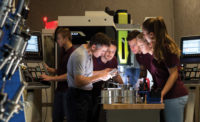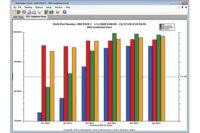The Internet of Things (IoT) is the new standard in manufacturing today, deeply affecting the way manufacturers operate. Improving Overall Equipment Effectiveness (OEE) is crucial to IoT.
Optimizing OEE requires accurate, up-to-date data across an entire organization, including measurement and test information from both quality labs and the shop floor.
Increasing the pace, capacity, and precision of measurement and inspection data collection is the first step in OEE. It can offer powerful insights that are crucial to improving efficiency and consistently manufacturing quality parts.
The best way to obtain quality control precision measurement data is through wireless and mobile retrieval technology.
Wireless data collection systems should be mobile as well as strongly encrypted and secured.
They should meet various needs ranging from unrestricted distances and gage compatibility to ease of use and practical integration into automated manufacturing operations.
Wireless data collection systems can considerably increase productivity, eliminate the potential for errors, deliver complete documentation, and automate the data acquisition process.
There are numerous reasons why manufacturers must gather precise, timely, and comprehensive measurement and inspection data. OEE, Lean, and Six Sigma initiatives necessitate reliable data to sustain rigorous quality control. Manufacturers — especially those in fields such as medical, biomedical, aerospace, and defense — must often meet regulatory requirements and provide traceable, consistent documentation.
Yesterday’s data collection systems don’t always support this. Here are just a handful of the issues they can cause:
- Possible human error and delay: When workers manually track important, particularly detailed, they are under enormous pressure to get it right. Obviously, this can create room for error, especially as workers take measurements dozens of times in a single shift. Organizations also may have to train staff to fully understand and accurately collect and transcribe data. Without proper education, employees can easily transpose digits or misplace decimal points, for example. Manual data collection can also take more time: Employees can’t work as steadfastly as machines.
- Cybersecurity concerns: Hackers can access a manufacturer’s data through unsecured measurement data. Older systems don’t always come with proper digital security measures.
- Lack of scalability: When businesses grow and diversify, they may need to expand their quality control processes. Data collection systems must be scalable to accommodate this. Setting up separate data collection processes can result in inaccuracies and delayed communication and can impact quality.
- Incomplete analysis: Sampling strategies are not dependable alternatives to 100%-part inspection and traceable documentation. They may impair predictions and the ability to spot identify changes in production tolerances. Some industries, such as medical or aerospace fields, won’t even allow it as a way to monitor quality.
Manufacturers that want to meet Industry 4.0 requirements must accurately and consistently acquire large amounts of measurement data. To do this, they need complete, scalable, secure, and robust wireless measuring data collection systems. Such systems are automated, ease to use, can easily scale, have robust data encryption and protection, and can transmit information across any distance.
These factors result in boosted productivity, fewer errors, and a dependable data acquisition process.
Today’s wireless networking technology uses short-wave radio frequencies to link phones, computers, and wireless devices to enable faster speed, greater bandwidth, and longer range for higher data throughput.



